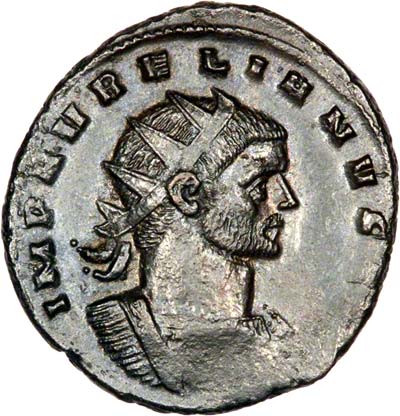| The Very Highest Quality Roman Portraits... |
| Portrait Gallery of Roman Emperors |

| |
Restorer of the World
Having secured his position on the Imperial Throne, Aurelian set out to continue the work begun by his predecessor in reuniting the Empire, which had fallen apart under Gallienus and divided into three sections, with the breakaway Gallic and Palmyrene Empires having declared their independence in the West and East respectively.
Having held in check the Barbarian threat to the Italian peninsula by 272 and begun the construction of a vast defensive wall to protect Rome*, Aurelian turned his attention towards recovering the lost provinces of the Palmyrene Empire, which he did in 273. In 274, it was the turn of the Gallic Empire under Tetricus to fall before the renewed might of Rome. In both cases, Aurelian spared the rebel rulers upon capture. Zenobia, formerly Queen of the Palmyrene Empire, was eventually released and became a key figure in Roman society, and Tetricus was not only released, but made governor of Southern Italy, probably due to his enthusiastic willingness to abdicate and defect to Aurelian before the battle that destroyed the Gallic Legions.
Assassination, Damnation and Deification
Aurelian was known for being a strict disciplinarian and having a no-nonsense soldierly attitude towards civil as well as military affairs. These qualities made him an excellent field commander and earned him respect amongst the legions he had led from one victory to another. However, they also made him many enemies amongst his own officials who were unaccustomed to being subject to harsh military discipline. He was known to execute or otherwise severely punish those he believed to be guilty of any kind of corruption. According to the Byzantine historian Zosimus (writing in the 5th-6th Century A.D.), Aurelian's personal secratary, Eros, was one of those officials, who had been caught out telling a lie in the course of his official duties. Fearing severe punishment for this once Aurelian found out, Eros drew up a forged document containing the names of other people close to the Emperor whom Aurelian was to condemn to death, and showed it to those whom he had named. Knowing the character of Aurelian, and perhaps their own characters as well, those named on Eros' false death list decided to pre-empt their apparent fate by murdering Aurelian before he could get to them. After his assassination, he was briefly subject to the damnatio memoriae by his opponents in the Senate, but the esteem in which he was held by others, particularly in the Army, ensured that this did not last for long and his memory was soon rehabilitated and deified. His formidable widow, Severina assumed control in the aftermath of her husband’s murder and ruled the Roman Empire for six months prior to the election of Tacitus to the Imperial Purple.
Currency Reform and the Revolt of Roman Mint Workers
Aurelian is of particular interest from a numismatic point of view due to the fact that under his reign, a serious revolt by mint workers in Rome took place in 271, led by Felicissimus, the master of the mint, as a result of Aurelian’s clampdown on the corrupt practice of making substandard coins for profit by retaining silver intended for use in the coinage. This revolt was not merely a riot or a strike that got out of hand, but a full-blown rebellion which, according to some ancient sources, cost the lives of as many as 7,000 soldiers and urban cohorts (police) before it was crushed (no doubt with even heavier casualties amongst the defeated side). Although the scale of Aurelian's casualties was probably exaggerated, the fact that such an enormous number has been suggested gives some indication of the vast manpower the Roman Mint required to produce coins for distribution throughout the whole Empire at a time of hyperinflation. However, it is likely that the mintworkers were not alone in their actions, and that the revolt was encouraged and supported by Aurelian's enemies in the Senatorial and Equestrian classes. The mint was closed for a while in the aftermath of the revolt, and the provincial mints gained more importance following this event. In addition, he attempted to deal with the rampant inflation in the economy by initiating a coinage reform in 274 which fixed the proportion of bronze to silver at 20 parts bronze to 1 part silver. This is reflected in the ‘XXI’ or ‘KA’ which appears at the bottom of the reverse on many of his post-reform antoninanii.
*This wall was finished under Probus. It still exists largely intact to this day and was still a formidable defensive barrier that had to be breached with a three hour artillery barrage and then stormed by Italian troops before Rome could be taken from the Papacy and the process of Italian unification completed in 1870.
Roman Emperors Portrait Gallery
You may wish to visit our portrait gallery of Roman emperors. Although it is not complete, we add new and better coins when we can. We are always keen to buy superior quality Roman coins to upgrade our photo gallery.
| ...at the Lowest Possible Price |
|
32 - 36 Harrowside, Blackpool, Lancashire, FY4 1RJ, England. Telephone (44) - (0) 1253 - 343081 ; Fax 408058; E-mail: info@chards.co.uk The URL for our main page is: https://24carat.co.uk Chard(1964) Ltd |